Distinguished Critique: Batman: Going Sane Review
Save for a few confusing moments, "Going Sane" is a strong, unique, strangely stirring examination of the Joker/Batman rivalry
—by Nathan on November 15, 2025—
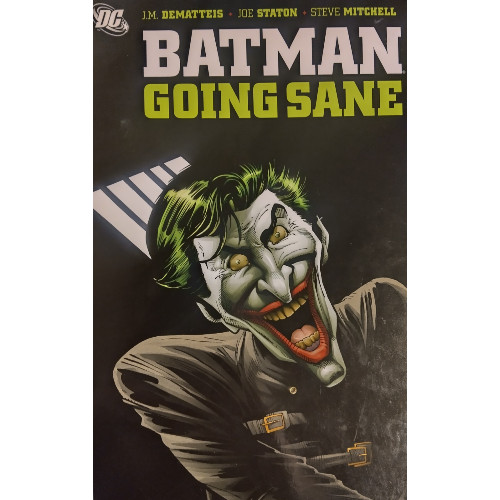
Before "Kraven's Last Hunt" was an actual published story, it was a pitch. It was a concept born in the mind of J.M. DeMatteis which underwent several revisions before landing on its final form. Initially, DeMatteis proposed a Wonder Man limited series where Simon's brother the Grim Reaper buried him alive. It was rejected.
Then DeMatteis went over to DC and suggested a narrative between the Joker and Batman. This, too, was rejected.
Then then it was reworked to involve Hugo Strange. Also rejected.
Finally, DeMatteis slipped back to Marvel, reworking the concept one more time and proposing a similar idea, just with Spider-Man and Kraven the Hunter in place of the DC characters.
You know the rest.
But across all its permutations, the idea which grew into "Kraven's Last Hunt" remained relatively the same: a villain, seemingly, finds a way to remove his heroic arch-foe from the picture permanently. I'm not sure if this also was the case with the Wonder Man/Grim Reaper proposal, but the other commonality across the narrative's other forms was the idea that it would explore a "What now?" scenario for the villain. With Spidey buried alive, what's Kraven to do with himself? If the Joker or Hugo Strange actually succeeded in killing Batman, what would be next for their careers or lives?
Though DeMatteis, paired with Mike Zeck, eventually got to explore this concept with "Kraven's Last Hunt," he'd later get an opportunity to approach the idea from a slightly different angle: denied at the time for being a tad too similar for the then-developing Batman: The Killing Joke graphic novel, DeMatteis' Batman/Joker narrative was resurrected for DC's Legends of the Dark Knight series, albeit at a time a bit distant from early stories I've already reviewed, "Shaman" and "Gothic". "Going Sane" is the result, a story which explores what would happen to the Joker with his greatest foe out of his life.
Is the joke still funny without the punchline?
"Going Sane"
Writers: J.M. DeMatteis, Eddie Campbell, and Daren White
Pencilers: Joe Staton and Bart Sears
Inkers: Steve Mitchell and Bart Sears
Colorists: Digital Chameleon and Mik Atiyeh
Letterers: Willie Schubert and Pat Brosseau
Issues: Legends of the Dark Knight #65-68, Legends of the Dark Knight #200
Publication Dates: November 1994-February 1995, April 2006
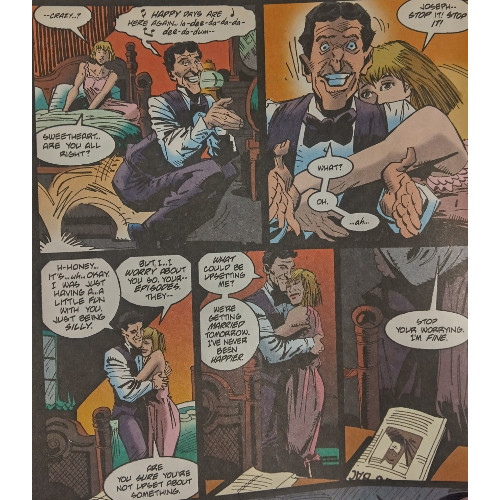
As DeMatteis provided a thoughtful examination of a "new" Spider-Man villain in a Spectacular Spider-Man annual I recently reviewed, I wanted to look at a different dose of characterization he provided DC in this narrative. Included in the volume I purchased is a different LOTDK story from a different creative team published in the early 2000s, which I will touch on later. For now, we're diving into the mind of the Clown Prince of Crime and seeing if we come out the other side with our sanity intact.
Maybe "mostly."
Whereas Kraven drugged Spider-Man, buried him, and assumed his identity, the Joker, believing his greatest adversary is dead, responds in a way you might find surprising. He doesn't announce himself the king of Gotham and rampage through the streets, blowing up banks or poisoning the water supply. Exulting, initially, in his newfound freedom from under Batman's enduring shadow, the man in the white facepaint quickly realizes that his whole meaning for existing is…gone. A moment late in the first issue shows green caption boxes, which Digital Chameleon and Willie Schubert have provided for the villain's internal monologue, take on a yellow color. With the "death" of Batman, so "dies" the Joker. Instead of considering his next criminal scheme, this man who was once a horrible arch-fiend and terrorist considers getting a job, finds an apartment, and removes or covers over his disquieting skin condition.
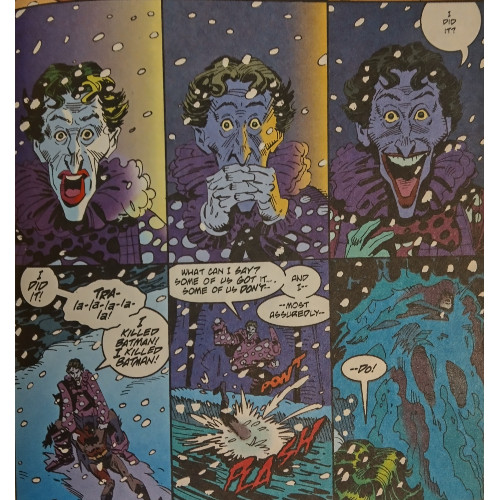
If you're a Batman reader, you've come across the "Does Batman cause the creation of his villains?" argument in at least one comic, and though DeMatteis never voices that question directly, it lies at the heart of this four-part story. You'd think Joker would love the freedom he's now allowed without the constant threat of a Batarang to the noggin and fearlessly rage against Gotham…but something inside him dies with Batman, whatever madness was preventing him from existing normally. It's not a psychologically sound concept, but for a story, it works pretty well. I'm not ending this tale thinking "Aw, man, if only Batman retired, then the Joker would stop killing people!" I don't believe that's the solution. But DeMatteis unravels what would need to happen for the Joker–now going by the name "Joseph Kerr"–to become normal, if we're setting aside the possibility of actual psychological rehabilitation.
DeMatteis develops a vein of empathy towards the former Clown Prince of Crime in a way I have never experienced in any other Batman comic I've read. When I first read through the issues, I kept skipping back, thinking I missed something. Surely, this couldn't be the same Joker, the one who beat Jason Todd mostly to death and crippled Barbara Gordon. Surely, this is a trick or fake-out of some kind. But, no, it isn't. It's all real. Joseph finds genuine happiness in this new guise through the love of a woman named Rebecca; they have dinner together, they watch old comedies and dance to old tunes, he buys her flowers…Joseph is just a regular guy, with a job, an apartment, a girlfriend. It's a surprisingly happy ending for one of the worst criminals in comics, and it does create a level of empathy. It's a look at the kind of life the Joker could experience if he were made whole and fully healthy in his mind. Instead of obsessing over Batman or causing chaos, he could enjoy a fulfilling life, like other regular people.
Does that make you feel guilty? It makes me feel guilty.
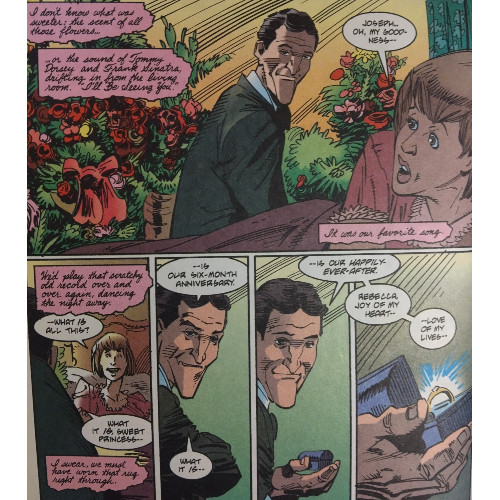
This is where the tension comes in, which DeMatteis plays with across the narrative's middle section. You see Joseph, you see his happiness and fulfillment, and you empathize with him. And then, if you're like me, you feel poorly for empathizing with him, because you know who he is, you know what he's done, and you believe he is absolutely undeserving of the love and normalcy he's found. The Joker starts this arc by blowing up a circus parade and kidnapping and beating a councilwoman. He seemingly kills Batman. And then he gets to just…walk away? Hide among humanity? Bravo, J.M. DeMatteis, for simultaneously making me feel for the Joker and then frustrate myself for feeling for the Joker. It's a question about what's more important, either the Joker's personal healing or the justice he should face for his crimes.
As DeMatteis allows us this struggle with the Joker's soul, he also provides a similar struggle for Batman. Bruce, unsurprisingly, has not died, finding himself carried to a town outside Gotham, where he is put up by a doctor and given time to recuperate. During his convalescence, he himself meets a woman and, just maybe, ponders the possibility of a life outside his broken city, away from the cloak of Batman. Like the Joker, Bruce is given a respite from his enduring shadow, but unlike Joseph Kerr, he cannot just switch back to normal. DeMatteis gives Bruce a moral gnawing, a fixation in his gut. He knows the Joker is loose, and he knows his responsibility to Gotham. That "more important" idea comes into play, as we know that, if Bruce returns to find Joseph, he will likely draw his greatest enemy out again. Would it be better for him to remain happy away from Gotham and to let Joseph remain so in Gotham?
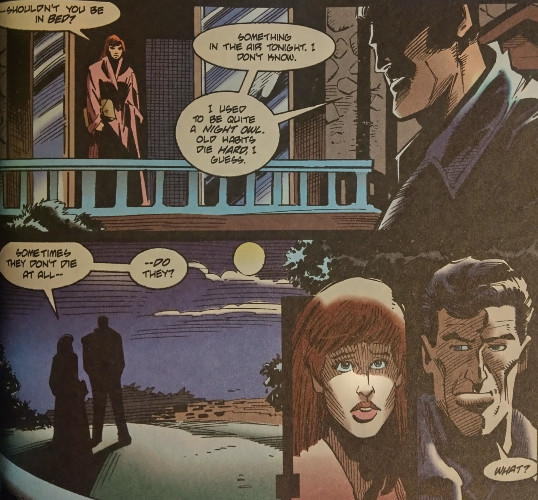
There are certain details DeMatteis is coy about, particularly in the later chapters, which I found myself somewhat frustrated with. A few plot points are structured in a nonlinear fashion, and though DeMatteis pulls the strings together eventually, I believe a few key details are left to the reader's imagination which should have been given outright. I do appreciate stories which allow the reader to interpret certain plot points or details, but here, it messes with the story's structure in a way which caused me momentarily confusion. DeMatteis crafts a particularly late scene in a "it may have happened this way, it may not have" fashion and avoids transitioning from one key moment to another, creating a vagueness where I would have appreciated clarity. Though I suppose it's a small price to pay when dealing with the Joker. This is, after all, the madman who once noted he preferred having his origin be multiple choice.
LOTDK #200, "Gotham Emergency," is included in the volume as well, and though it focuses on the Joker, it has no thematic relation to "Going Sane" whatsoever. Told from the perspective of a rookie doctor at a major Gotham hospital, this standalone narrative blends her empathy for the Joker's victims following a bombing and the onrush of care the hospital must provide, including, in a bit of a twist, the pasty-faced maniac himself. As a single-issue story, it has merit, though there's nothing to suggest much logic for it being included with "Going Sane" outside of whoever developed the volume wanting to tack on another issue, presumably to pad the paperback a tad. I won't complain about another story being added; I just assume another tale, more thematically aligned with "Going Sane," would have made more sense. Even just the LOTDK issue or issues following "Going Sane" would have been a better option than a single issue published twelve years after DeMatteis' four-parter.
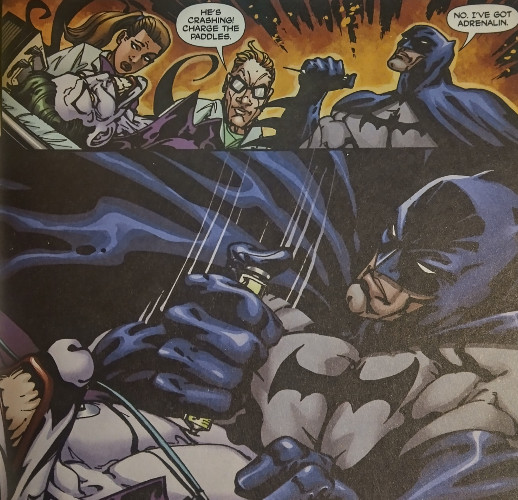
Aside from a few lacking details, "Going Sane" is a strong inclusion in the "best of" Batman/Joker stories. Amazingly, it's a narrative where the non-Batman/non-Joker elements work best, as DeMatteis and Staton craft the story of two men whose lives could look different were they not so wrapped up in their mutual bitterness and the identities which drive them. A moment where Bruce returns to the Batcave, surprising an Alfred who has been in mourning, contains both the fist-pumping bravado of a hero reclaiming his mantle and the bizarre bitterness that you know will come with resuming the status quo. Batman cannot let his darker self die, no matter how often that clown tries to kill him, no matter how idyllic life would appear without that shadow he casts over himself…and DeMatteis and Staton argue such a concept exists for the Joker as well. One cannot live without the other, and though Batman isn't responsible for the Joker or his actions, "Going Sane" argues, fairly strongly, that neither man can rest knowing the other exists. And there's the rub. Death, it appears, would be the only way that either the vigilante or the villain could ever find true, lasting peace.